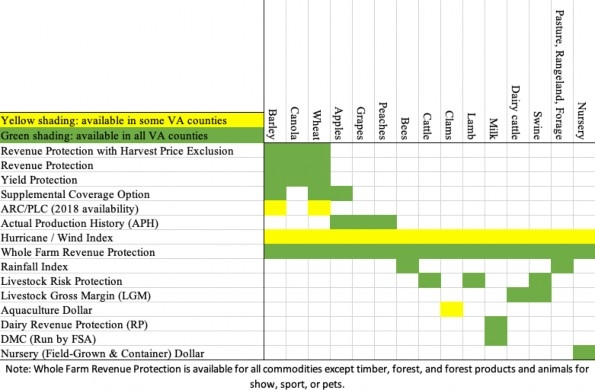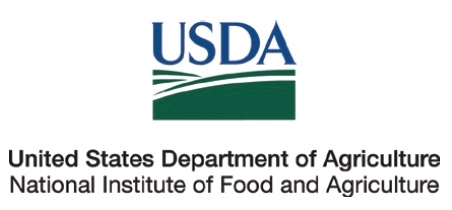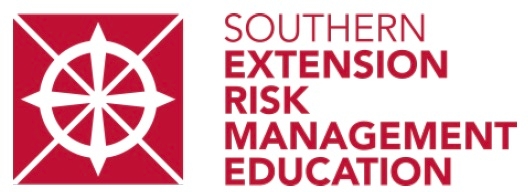Risk Management and Crop Insurance
ID
AAEC-282NP
What is crop insurance?
The federal crop insurance program is managed by the USDA Risk Management Agency (RMA). The crop insurance program helps to protect producers against low-revenue years. The availability of policy varies by crop/species, by county, and by year. The chart on the next page shows crop insurance policy availability for Virginia for 2021. Crop insurance can be purchased through an RMA Approved Insurance Provider (AIP).
The federal crop insurance program is supplemented by the Price Loss Coverage (PLC) program and the Agricultural Risk Coverage (ARC) program. These programs are available to producers of wheat, oats, barley, corn, grain sorghum, rice, soybeans, sunflower seed, rapeseed, canola, safflower, flaxseed, mustard seed, crambe and sesame seed, seed cotton, dry peas, lentils, small chickpeas, large chickpeas, and peanuts. Producers can opt into one of the two programs if they participate in conservation programs.
How does crop insurance work?
Traditional crop insurance reimburses in two situations
- When a natural event causes low production. These events may include droughts, floods, extreme weather, disease, or wildfire. This insurance is called Yield Protection and it insures the number of bushels per acre.
- When revenue is low. Revenue Protection insures farmers by their revenue per acre.
Similar to most insurance programs, producers estimate the value of their farm and pay an insurance premium for their desired level of coverage.
Producers may elect to insure their entire production or some percentage of their expected yield. Additionally, some insurance policies exist at the county level instead of the individual farm level. These policies cover operations based on conditions or problems in that county.
What other policies are available?
Some crop insurance policies are based solely on weather. These include rainfall index insurance and hurricane-wind index insurance. Operations with beehives and pastures are eligible for protection against rainfall irregularities. Wind index insurance is available to producers of barley, wheat, apples, grapes, and nurseries in some counties. Coverage against wind and hurricanes is available for canola and cattle in all counties.
For dairy farmers, Dairy Margin Coverage is available through the USDA’s Farm Service Agency (FSA). Farmers can cover between 5% and 95% of their milk production—although they must have a production history determined by the FSA. Farmers may also enroll in Livestock Gross Margin insurance (LGM-Dairy) or Revenue Protection insurance (Dairy-RP).
The chart on the next page shows the full set of policies currently available for Virginia producers. Please visit the websites listed under “References” for more detailed information.

Acknowledgments
We thank Professor Rory O. Maguire, Crop and Environmental Sciences, Virginia Tech, for his helpful comments.
This material is based upon work supported by USDA/NIFA under Award Number 2018-70027- 28585.


References
“Agriculture Risk Coverage and Price Loss Coverage Programs.” Farmers.gov: Resources for Farmers and Producers. USDA. https://www.farmers.gov/arc-plc.
“Agricultural Risk Coverage (ARC) & Price Loss Coverage (PLC).” Farm Service Agency Fact Sheet. USDA, August 2019. https://www.fsa.usda.gov/Assets/USDA-FSA- Public/usdafiles/FactSheets/2019/arc-plc_overview_fact_sheet-aug_2019.pdf
“Apiculture Pilot Insurance Program.” Risk Management Agency National Fact Sheets. USDA, July 2017. https://www.rma.usda.gov/Fact-Sheets/National-Fact-Sheets/Apiculture-Pilot-2017.
“Apples.” Risk Management Agency Regional Fact Sheets. USDA, August 2018. https://rma.usda.gov/Fact-Sheets/Raleigh-Regional-Office-Fact-Sheets/Apples-2018-CT- WV.
“Aquaculture (Oysters, Clams, WFRP).” Risk Management Agency National Fact Sheets. USDA, February 2020. https://www.rma.usda.gov/Fact-Sheets/National-Fact-Sheets/Aquaculture-Oysters-Clams-WFRP.
“Canola and Rapeseed.” Risk Management Agency National Fact Sheets. USDA, September 2019. https://rma.usda.gov/en/Fact-Sheets/National-Fact-Sheets/Canola-and-Rapeseed.
Crop Report Criteria. Risk Management Agency. USDA, 2021. https://webapp.rma.usda.gov/apps/ActuarialInformationBrowser2021/CropCriteria.aspx.
“Dairy Margin Coverage Program.” Farm Service Agency Fact Sheets. USDA, June 2019. https://www.fsa.usda.gov/Assets/USDA-FSA-Public/usdafiles/FactSheets/2019/
dairy_margin_coverage_program-june_2019_fact_sheet.pdf.
“Dairy Revenue Protection.” Risk Management Agency National Fact Sheets. USDA, April 2019. https://www.rma.usda.gov/en/Fact-Sheets/National-Fact-Sheets/Dairy-Revenue-Protection.
GIS Map Site. Risk Management Agency, USDA. https://prodwebnlb.rma.usda.gov/apps/MapViewer/index.html.
“Hurricane Insurance Protection – Wind Index (HIP- WI) Endorsement.” Risk Management Agency National Fact Sheets. USDA, 2020. https://rma.usda.gov/en/Fact-Sheets/National- Fact-Sheets/Hurricane-Insurance-Protection-CY-2020.
“Livestock Gross Margin Insurance Dairy Cattle.” Risk Management National Fact Sheets. USDA, June 2019. https://www.rma.usda.gov/en/Fact- Sheets/National-Fact-Sheets/Livestock-Gross-Margin-Insurance-Dairy-Cattle.
“Livestock Gross Margin Swine.” Risk Management Agency National Fact Sheets. USDA, July 2020. https://www.rma.usda.gov/en/Fact-Sheets/National-Fact-Sheets/Livestock-Gross- Margin-Swine.
“Livestock Risk Protection Fed Cattle.” Risk Management Agency National Fact Sheets. USDA, January 2021. https://www.rma.usda.gov/en/Fact-Sheets/National-Fact-Sheets/Livestock-Risk-Protection-Fed-Cattle.
“Livestock Risk Protection Feeder Cattle.” Risk Management Agency National Fact Sheets. USDA, January 2021. https://www.rma.usda.gov/en/Fact-Sheets/National-Fact-Sheets/Livestock-Risk-Protection-Feeder-Cattle.
“Livestock Risk Protection Lamb.” Risk Management Agency National Fact Sheets. USDA, April 2018. https://www.rma.usda.gov/Fact-Sheets/National-Fact-Sheets/Livestock-Risk-Protection-Lamb-2018.
“Livestock Risk Protection Swine.” Risk Management Agency National Fact Sheets. USDA, January 2021. https://www.rma.usda.gov/en/Fact-Sheets/National-Fact-Sheets/Livestock-Risk-Protection-Swine.
Newton, John. “What Is Dairy Revenue Protection?” American Farm Bureau Federation - The Voice of Agriculture, August 22, 2017.
https://www.fb.org/market-intel/what-is-dairy-revenue-protection.
“Nursery Commodity Insurance.” Risk Management Agency National Fact Sheets. USDA, February 2018. https://www.rma.usda.gov/en/Fact-Sheets/National-Fact-Sheets/Nursery-Commodity-Insurance.
“Pasture, Rangeland, Forage.” Risk Management Agency National Fact Sheets. USDA, August 2017. https://www.rma.usda.gov/Fact-Sheets/National-Fact-Sheets/Pasture-Rangeland-Forage-Pilot-Insurance-Program.
Pasture, Rangeland, Forage Support Tool. Risk Management Agency, USDA https://prodwebnlb.rma.usda.gov/apps/prf.
“Peaches.” Risk Management Agency Regional Fact Sheets. USDA, October 2017. https://www.rma.usda.gov/Fact-Sheets/Raleigh-Regional-Office-Fact-Sheets/Peaches-2018-MD-PA.
“Small Grains: Barley and Wheat.” Risk Management Agency National Fact Sheets. USDA, September 2019. https://www.rma.usda.gov/en/Fact-Sheets/National-Fact-Sheets/Small-Grains---Barley-Wheat.
“Supplemental Coverage Option for Federal Crop Insurance.” Risk Management Agency National Fact Sheets. USDA, October 2018. https://www.rma.usda.gov/Fact-Sheets/National- Fact-Sheets/Supplemental-Coverage-Option-2018.
“Whole-Farm Revenue Protection.” Risk Management Agency National Fact Sheets. USDA, August 2019. https://www.rma.usda.gov/en/Fact-Sheets/National-Fact-Sheets/Whole-Farm-Revenue-Protection-2020.
Virginia Cooperative Extension materials are available for public use, reprint, or citation without further permission, provided the use includes credit to the author and to Virginia Cooperative Extension, Virginia Tech, and Virginia State University.
Virginia Cooperative Extension is a partnership of Virginia Tech, Virginia State University, the U.S. Department of Agriculture (USDA), and local governments, and is an equal opportunity employer. For the full non-discrimination statement, please visit ext.vt.edu/accessibility.
Publication Date
March 25, 2021



